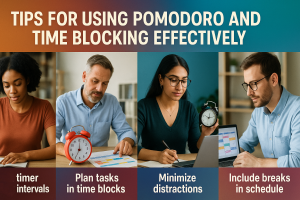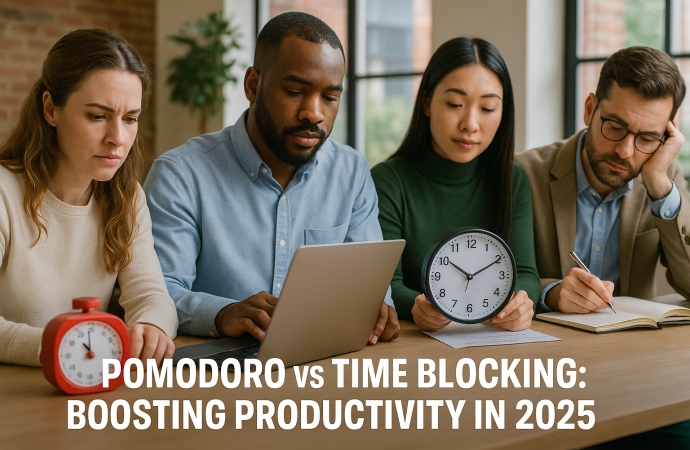Introduction In today’s fast-paced world, staying productive is more important than ever. With so many tasks to juggle, it’s easy to get distracted and overwhelmed. Fortunately, productivity techniques like Pomodoro vs time-blocking offer simple ways to stay on track and get more done. These methods have gained significant popularity due to their effectiveness in helping
Introduction
In today’s fast-paced world, staying productive is more important than ever. With so many tasks to juggle, it’s easy to get distracted and overwhelmed. Fortunately, productivity techniques like Pomodoro vs time-blocking offer simple ways to stay on track and get more done. These methods have gained significant popularity due to their effectiveness in helping individuals manage their time efficiently.
In 2025, more professionals are turning to these techniques to stay focused, increase efficiency, manage daily task workloads, and complete tasks. But how do you know which one is right for you? In this article, we’ll dive into Pomodoro vs Time Blocking, comparing each method’s strengths and weaknesses and offering insights into how you can boost your productivity using both.
What Is the Pomodoro Technique?

Image by: Yandex.com
The Pomodoro Technique is a time management method developed by Francesco Cirillo in the late 1980s. The technique is named after the Italian word for “tomato,” inspired by the tomato-shaped kitchen timer Cirillo used when developing the system.
The Pomodoro technique works by breaking down important tasks into short, focused intervals called Pomodoros (usually 25 minutes), followed by a short break (5 minutes). After completing four Pomodoros, you take a longer break (15–30 minutes). This approach encourages intense focus during each Pomodoro and ensures your brain gets the rest it needs to stay fresh and productive.
Key Features of Pomodoro:
- Work in 25-minute intervals
- Take short breaks (5 minutes) after each interval
- Take a longer break (15–30 minutes) after completing four Pomodoros
- Track your work and progress
Pomodoro’s Strengths:
- It encourages deep focus by setting a timer that prompts you to stay on task.
- Frequent breaks help prevent burnout and keep you energized.
- The method is easy to follow, and no special tools are required except a timer.
Pomodoro’s Weaknesses:
- The 25-minute work intervals may feel too short for tasks that require deep thinking or long periods of concentration.
- Pomodoro may not suit jobs that involve unpredictable or long-duration meetings and tasks.
What Is Time Blocking?

Image by: Yandex.com
Time blocking is a productivity technique where you schedule specific blocks of time in your calendar to focus on different assign tasks or activities. Unlike Pomodoro, where you work in short bursts, time blocking allows you to plan your entire day or week by assigning large chunks of time for specific tasks, projects, or even breaks.
This method requires you to group similar activities together and allocate them a set time, making it easier to focus on one task at a time. The goal is to reduce multitasking and interruptions by having a clear plan for when each activity will be completed.
Key Features of Time Blocking:
- Plan your day/week ahead with set time blocks
- Assign specific tasks to each block of time
- Include time for breaks, meetings, and other activities
- Stick to the set schedule to stay on track
Time Blocking’s Strengths:
- Provides a clear structure for your day, helping you stay organized.
- Effective for tasks that require long, uninterrupted focus.
- Allows you to set time for various activities, including meetings, exercise, and personal time.
- Great for tackling big projects by breaking them into smaller tasks.
Time Blocking’s Weaknesses:
- Rigid schedules may be difficult to follow in dynamic environments with constant changes.
- It requires good planning and discipline to avoid overbooking or mismanaging time blocks.
- It may not allow for flexibility if tasks take longer or shorter than expected.
Pomodoro vs Time Blocking: Which One is Right for You?

Image by: Chatgpt.com
Both Pomodoro and time blocking are effective techniques for boosting productivity, but each has unique advantages and is suited to different work styles and environments. Let’s compare the two methods to see which one might work best for you in 2025.
1. Focus and Attention
- Pomodoro is designed to help you stay focused by creating small windows of intense work. The short work intervals allow you to give your full attention to a task without feeling overwhelmed.
- Time blocking gives you more extended periods of focus, allowing you to dive deeper into tasks or projects that require longer concentration.
2. Task Complexity
- Pomodoro works best for tasks that are repetitive or straightforward, where you can break them into smaller chunks and focus intensely for short periods.
- Time blocking is ideal for larger, more complex tasks that require multiple steps or a long time to complete. You can allocate a longer block of time for these tasks to ensure they get done properly.
3. Flexibility
- Pomodoro is more flexible in terms of how you organize your day. You can adapt the intervals to suit your energy levels and task requirements, and the method is simple to follow without much preparation.
- Time blocking offers less flexibility as your schedule is planned in advance. However, it provides a clear structure that helps you stay on track and manage your time more effectively.
4. Meetings and Collaboration
- Pomodoro can be less practical for meetings and collaborative work. The short work periods may disrupt communication with others, making it difficult to adjust to changing schedules.
- Time blocking works well with meetings and team collaborations. You can allocate blocks of time for specific meetings or group activities, ensuring that collaboration is built into your day.
Tips for Using Pomodoro and Time Blocking Effectively

Image by: Chatgpt.com
1. Mix Both Methods
You don’t have to choose between Pomodoro and time blocking. You can combine the two techniques for maximum productivity. For example, use time blocking to schedule large chunks of your day, and within those blocks, apply the Pomodoro technique for focused work periods.
2. Adjust the Pomodoro Intervals
While the standard Pomodoro interval is 25 minutes, you can adjust the length to better suit your tasks. If you need longer focus periods, try working in 50-minute intervals with 10-minute breaks, or even 90-minute intervals with longer breaks.
3. Use Technology to Track Time
Use productivity apps like Trello, Google Calendar, or Focus Booster to schedule and track your time blocks and Pomodoros. These tools can help you stay organized, track progress, and avoid distractions.
4. Prioritize Tasks
No matter which method you use, it’s essential to prioritize tasks based on importance and deadlines. Identify high-priority tasks and allocate your best time blocks or Pomodoros to them, ensuring that you stay on top of important projects.
Future of Pomodoro and Time Blocking

Image by: Chatgpt.com
Looking ahead, these tools will get smarter and more seamless. Calendar apps or time tracking may suggest time-block lengths based on your past habits and energy peaks. Pomodoro timers could adapt sprint times if you’re on a roll or need a longer break. AI assistants might auto-create blocks when new tasks pop up and nudge you when it’s time to switch. Team dashboards could show who is in focus mode or open for chat in real time. As these updates arrive, Pomodoro and time blocking will become natural parts of a more focused, task management, flexible workday.
Comparative Table: Pomodoro vs Time Blocking Key Differences
| Aspect | Pomodoro | Time Blocking |
|---|---|---|
| Focus Duration | 25 minutes of focused work, 5-minute breaks | Longer, scheduled blocks for deep work or tasks |
| Best For | Short, repetitive tasks, preventing burnout | Complex tasks requiring long concentration |
| Flexibility | High easily adapted to short bursts of work | Low requires planning and commitment |
| Use for Meetings | Less ideal for meetings or collaborative tasks | Perfect for scheduling team collaboration or meetings |
| Breaks | Built-in short breaks after each Pomodoro | Breaks are scheduled but may be fewer or longer |
| Task Management | Tasks are broken down into smaller chunks | Tasks are planned into larger blocks of time |
Conclusion
In 2025, both Pomodoro and time blocking are excellent tools for boosting productivity. Pomodoro works best for tasks that require short bursts of focus, while time blocking is ideal for more extended, complex projects. The key is finding the technique that suits your work style and goals.
Whether you decide to use Pomodoro to stay focused for short intervals or time blocking to organize your entire day, both methods can help you work smarter, not harder. Don’t be afraid to experiment with both time management techniques and see which works best for you.






















